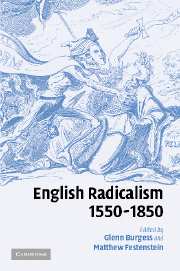Book contents
- Frontmatter
- Contents
- List of contributors
- Introduction
- Chapter 1 A politics of emergency in the reign of Elizabeth I
- Chapter 2 Richard Overton and radicalism: the new intertext of the civic ethos in mid seventeenth-century England
- Chapter 3 Radicalism and the English Revolution
- Chapter 4 ‘That kind of people’: late Stuart radicals and their manifestoes, a functional approach
- Chapter 5 The divine creature and the female citizen: manners, religion, and the two rights strategies in Mary Wollstonecraft's Vindications
- Chapter 6 On not inventing the English Revolution: the radical failure of the 1790s as linguistic non-performance
- Chapter 7 Disconcerting ideas: explaining popular radicalism and popular loyalism in the 1790s
- Chapter 8 Henry Hunt's Peep into a Prison: the radical discontinuities of imprisonment for debt
- Chapter 9 Jeremy Bentham's radicalism
- Chapter 10 Religion and the origins of radicalism in nineteenth-century Britain
- Chapter 11 Joseph Hume and the reformation of India, 1819–33
- AFTERWORDS
- Index
Chapter 4 - ‘That kind of people’: late Stuart radicals and their manifestoes, a functional approach
Published online by Cambridge University Press: 26 June 2009
- Frontmatter
- Contents
- List of contributors
- Introduction
- Chapter 1 A politics of emergency in the reign of Elizabeth I
- Chapter 2 Richard Overton and radicalism: the new intertext of the civic ethos in mid seventeenth-century England
- Chapter 3 Radicalism and the English Revolution
- Chapter 4 ‘That kind of people’: late Stuart radicals and their manifestoes, a functional approach
- Chapter 5 The divine creature and the female citizen: manners, religion, and the two rights strategies in Mary Wollstonecraft's Vindications
- Chapter 6 On not inventing the English Revolution: the radical failure of the 1790s as linguistic non-performance
- Chapter 7 Disconcerting ideas: explaining popular radicalism and popular loyalism in the 1790s
- Chapter 8 Henry Hunt's Peep into a Prison: the radical discontinuities of imprisonment for debt
- Chapter 9 Jeremy Bentham's radicalism
- Chapter 10 Religion and the origins of radicalism in nineteenth-century Britain
- Chapter 11 Joseph Hume and the reformation of India, 1819–33
- AFTERWORDS
- Index
Summary
On Christmas eve, 1683, the Scot James Stewart, having been arrested for smuggling letters from the exile community in the Netherlands to London, professed not to know the conspirator Robert Ferguson ‘nor any of that kind of people’. Both Stewart and his interrogator(s) understood what sort of people he meant. Indeed, contemporaries used a variety of terms, mostly pejorative, in referring to them. Typically the critics of ‘that kind of people’ spoke of them as fanatics or the disaffected, often linking the terms together. At the burial of the Particular Baptist Henry Jessey in September 1663, the Newes reported that ‘a strange Medly of Phanatiques’ accompanied the corpse. The term was used indiscriminately for such people as Protestant nonconformists, the northern rebels in 1663, Sidney Bethel, the Whigs, the militant Covenanters organized as the United Societies, and the ‘many enthusiastique fanaticall men’ who comprised the main body of Covenanters. Not surprisingly, the imprecision could cause problems, as in the summer of 1683, when local magistrates received orders to confiscate weapons from the disaffected; one official asked the lieutenant of Dover Castle if there were ‘any notice or direction what principle or profession I ought [to] take for a distinction of disaffection’. The Earl of Lindsey thought the order extended to all people justly suspected of being potential supporters of an insurrection. Whatever their shortcomings, terms such as fanatic, disaffected and ill-affected were normally clear enough to convey the user's meaning.
- Type
- Chapter
- Information
- English Radicalism, 1550–1850 , pp. 87 - 114Publisher: Cambridge University PressPrint publication year: 2007
- 1
- Cited by



